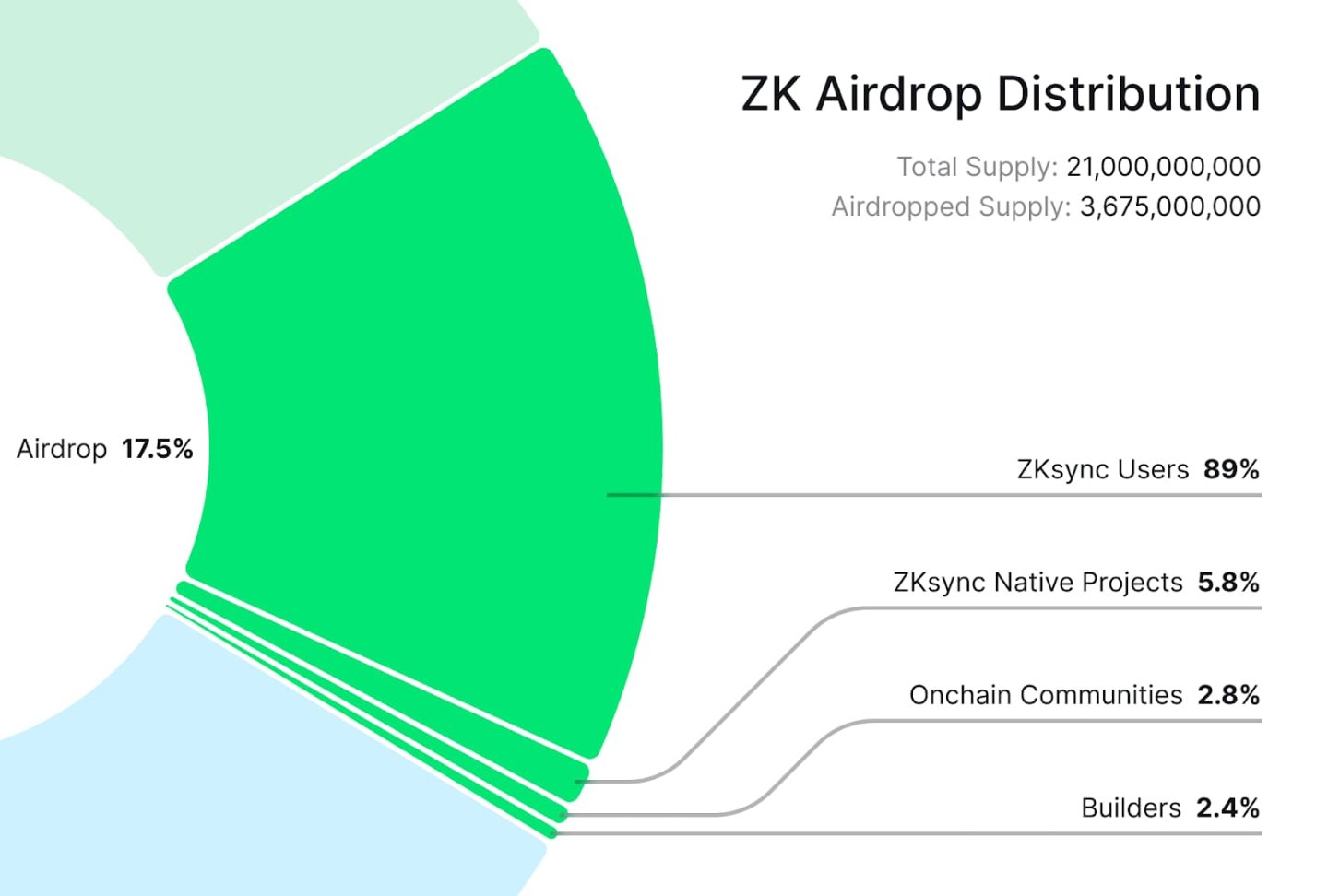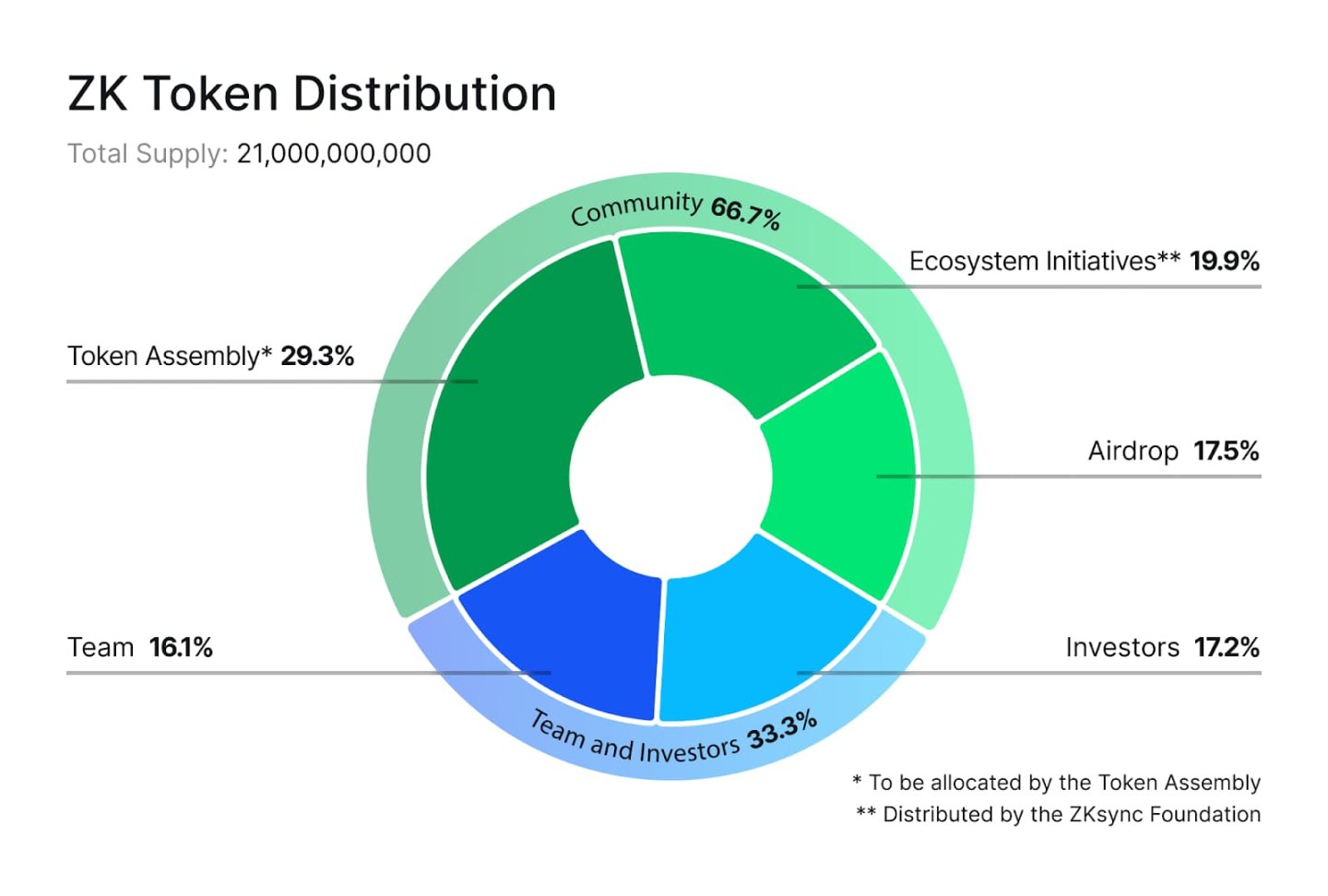Грядет большое событие. Ознакомьтесь с правилами и подробностями распространения zkSync.
Compiled by Karen, Foresight News
The much-anticipated ZKsync airdrop distribution plan has been finalized. The ZKsync Association will conduct a one-time airdrop of 3.6 billion ZK tokens to early users and adopters of ZKsync next week, with 695,232 eligible wallets. The snapshot time is March 24th, and community members can check the airdrop eligibility on the claim.zknation.io website and claim the airdrop starting next week until January 3, 2025.
The airdrop represents 17.5% of the total supply of ZK tokens. Users will be able to claim their tokens starting next week until January 3, 2025. Contributors will be able to claim starting June 24.
Who is eligible for the ZKsync airdrop?
Two categories of ZKsync users are eligible for a total of 17.5% of the airdrops:
1. Users (89%): ZKsync users who have transacted on ZKsync and reached the activity threshold.
2. Contributors (11%): Individuals, developers, researchers, communities, and companies that contribute to the ZKsync ecosystem and protocol through development, advocacy, or education (not related to activities on ZKsync).
Eligibility and allocation for the airdrop are based on a snapshot of ZKsync Era and ZKsync Lite activity taken at 00:00 UTC on March 24, 2024, to mark the first anniversary of the ZKsync Era mainnet launch.
How is the ZKsync airdrop distributed?
Eligibility: ZKsync checked every address that has transacted on ZKsync Era and ZKsync Lite against the eligibility criteria to identify real users who are serious about spending time exploring ZKsync. Each address must have at least one credit to be eligible for the airdrop.
Allocation: After determining the eligibility of the wallet, the airdrop allocation is calculated based on the crypto assets that cross-chain to the ZKsync Era. The formula adjusts the addresss allocation based on the assets it has in the ZKsync Era (in the wallet and in DeFi) and how long those assets have existed in the ZKsync era. The more points you earn, the larger the final allocation, with a single address capped at 100,000 ZKs.
Multipliers: Each address can earn multipliers based on activity that indicates real human behavior or a high likelihood of contributing to ZKsync. These multipliers apply to eligibility and allocation for both ZKsync Era and Lite usage.
-
Own ZKsync native NFT;
-
Support the ZKsync ecosystem by holding the ZKsync native ERC 20 token;
-
Experiment with ZKsync Era鈥檚 native account abstraction using a smart contract wallet;
-
Receive and hold previous airdrops from other ETH communities;
-
Trade with major ETH mainnet smart contracts and explore new use cases and DApps.
Each address that meets the above Eligibility, Allocation and Maturity is granted a token allocation. A single address must meet the minimum requirement of 450 ZK, and the airdrop is capped at 100,000 ZK. Tokens of addresses with less than 450 ZK will be recycled back to the pool.
Sybil Detection: This airdrop is designed to reward real users. The vast majority of Sybil addresses have been eliminated through eligibility and distribution criteria. Each wallet goes through an additional Sybil detection step. ZKsync says there are more than 6 million unique addresses on ZKsync Era, and the ZK airdrop focuses on using a people-centric approach to identify real users. The on-chain history of a wallet reveals a lot about the habits of its owner. Real people are often willing to take risks, especially those who feel like they are part of a community. They spend time on the chain, ape in, trade, try new protocols, and hold speculative assets. Assets connected by real users will eventually flow into DApp and DeFi protocols, becoming the lifeblood of a high-liquidity ecosystem. Users should be rewarded in proportion to their impact on the success of ZKsync.
More than half (5.8%) of the contributor airdrops are allocated to the treasury of ZKsync native projects based on ZKsync Era, including DeFi protocols, ZK chains, NFT collections, decentralized markets, infrastructure, games, etc. The remaining contributor airdrops are allocated to contributors, companies, and individuals who laid the foundation for ZKysnc:
1. Contributors to the Ethereum development organization, including implementation clients, consensus clients, developer tools, RPC, and other projects that have a positive impact on ZKsync.
2. Contributors to Github repositories who have advanced blockchain technology and have directly or indirectly contributed to the success of ZKsync, including important work related to blockchain, zero-knowledge proofs, developer tools, and developer education.
3. Educator who provides training to developers and security researchers, and contributes to the ZKsync Community Center on GitHub.
Contributor to Github repositories working on zero-knowledge proofs, Ethereum development tools, and open source software.
4. Security researchers who participate in audit competitions hosted by Cantina, Code 4 rena, and CodeHawks.
5. ZKsync community mods, ZK Credo translators, ZK Quest participants, and live event participants.
Additionally, 0.4875% of the total supply has been allocated to a small group of experimental on-chain communities exploring new ways to organize with tokens and NFTs. These communities include $DEGEN and $BONSAI airdrop recipients, Crypto the Game players, and Pudgy and Milady holders.
The ZKsync snapshot is March 24th, and community members can check airdrop eligibility on the Claim.zknation.io website and can claim the airdrop starting next week until January 3, 2025. Eligible GitHub developers and ZKsync GitHub Discussion Helpers must link their addresses to their accounts by June 25th. External projects, Protocol Guild, and ZKsync native project contributors will be able to claim starting June 24, 2024.
How are ZKsync tokens distributed?
The total supply of ZK tokens is 21 billion tokens. In addition to airdrops, the community allocation accounts for 66.7%, the ecosystem incentive accounts for 19.9% (distributed by the ZKsync Foundation), the investor allocation accounts for 17.2%, the team allocation accounts for 16.1%, and the Token Assembly allocation accounts for 29.3%. The tokens allocated to investors and the team will be locked in the first year and then unlocked in 3 years between June 2025 and June 2028.
ZKsync said that two-thirds (about 67%) of the ZK tokens will be allocated to the community. Among them, 17.5% of the total supply will be distributed through a one-time airdrop, and the remaining community tokens will be distributed over time through ecosystem plans managed by the ZKsync Foundation and ZK Nation governance processes to support the growing ecosystem.
This article is sourced from the internet: The big one is coming. Take a quick look at the zkSync airdrop rules and distribution details
Original author: TechFlow After much anticipation, Eigenlayer finally released more details of its token economy today and announced that it will allocate 15% of EIGEN tokens to users who previously participated in re-staking through linear unlocking. Does the EIGEN token have more value? What is its specific use? What impact can it have on re-staking and even the entire Ethereum ecosystem? The answers are all in this 40+ page token economics white paper released by Eigenlayer. Unlike most projects that simply sketch out a few token release diagrams when introducing the token economy, Eigenlayer spent a lot of time and effort to explain the role of the EIGEN token and its relationship with the ETH token in a detailed, meticulous, and even somewhat technically geeky way. The DeepChao research team…









